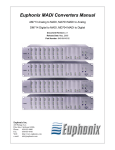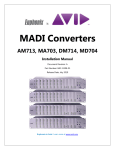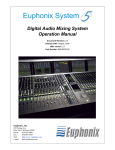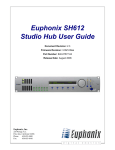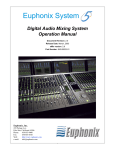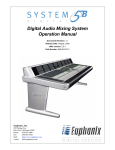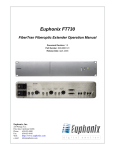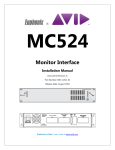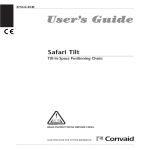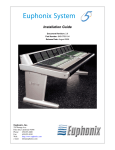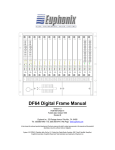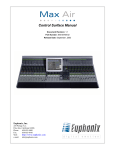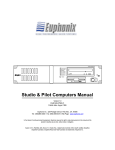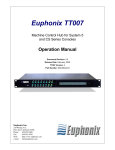Download Euphonix R-1 audio deck Specifications
Transcript
Euphonix MADI Converters Manual AM713 Analog to MADI, MA703 MADI to Analog DM714 Digital to MADI, MD704 MADI to Digital Document Revision: 2.1 Release Date: December, 2003 Part Number: 840-08416-02 Euphonix Inc. 220 Portage Ave. Palo Alto, California 94306 Phone: 650-855-0400 Fax: 650-855-0410 Web: http://www.euphonix.com e-mail: [email protected] In the interest of continued product development, Euphonix Inc. reserves the right to make improvements in this manual and the products it describes at any time, without notice or obligation. System 5, S5, Max Air, PatchNet, eMix, EuCon, R-1, Audio Deck, Studio Hub are trademarks of Euphonix, Inc. ©2002 Euphonix, Inc. All rights reserved worldwide. No part of this publication may be reproduced, transmitted, transcribed, stored in a retrieval system, or translated into any language in any form by any means without written permission from Euphonix, Inc. Manual design by Rob Wenig. Manual written by Tim Driedger and Rob Wenig. IMPORTANT SAFETY INSTRUCTIONS The lighting flash with arrowhead symbol within an equilateral triangle, is intended to alert the user to the presence of uninsulated “dangerous voltage” within the product’s enclosure that may be of sufficient magnitude to constitute a risk of electrical shock to persons. The exclamation point within an equilateral triangle, is intended to alert the user to the presence of important operating and maintenance (servicing) instructions in the literature accompanying the product. 1) Read these instructions. 2) Keep these instructions. 3) Heed all warnings. 4) Follow all instructions. 5) Do not use this apparatus near water. 6) Clean only with a dry cloth. 7) Do not block any ventilation openings. Install in accordance with the manufacturer’s instructions. 8) Do not install near any heat sources such as radiators, heat registers, stoves, or other apparatus (including amplifiers) that produce heat. 9) Do not defeat the safety purpose of the polarized or grounding-type plug. A polarized plug has two blades with one wider than the other. A grounding type plug has two blades and a third grounding prong. The wider blade or the third prong are provided for your safety. If the provided plug does not fit into your outlet, consult an electrician for replacement of the obsolete outlet. 10) Protect the power cord from being walked on or pinched particularly at plugs, convenience receptacles, and the point where they exit from the apparatus. 11) Only use attachments/accessories specified by the manufacturer. 12) Use only with the cart, stand, tripod, bracket, or table specified by the manufacturer, or sold with the apparatus. When a cart is used, use caution when moving the cart/apparatus combination to avoid injury from tip-over. 13) Unplug this apparatus during lightning storms or when unused for long periods of time. 14) Refer all servicing to qualified service personnel. Servicing is required when the apparatus has been damaged in any way, such as power-supply cord or plug is damaged, liquid has been spilled or objects have fallen into the apparatus, the apparatus has been exposed to rain or moisture, does not operate normally, or has been dropped. 15) WARNING – TO REDUCE THE RISK OF FIRE OR ELECTRIC SHOCK, DO NOT EXPOSE THIS APPARATUS TO RAIN OR MOISTURE. 16) Do not expose this equipment to dripping or splashing and ensure that no objects filled with liquids, such as vases, are placed on the equipment. 17) To completely disconnect this equipment from the AC Mains, disconnect the power supply cord plug from the AC receptacle. 18) The mains plug of the power supply cord shall remain readily operable. 19) This unit is provided with a power supply cord set suitable for 120V AC input only (for U.S.A. and Canada). For other than U.S.A. and Canada, a qualified person must provide for use with this unit, an appropriate, approved power supply cord set which is in compliance with the end use country requirements and has a minimum cross-sectional area of 1.0mm2. 20) For units with more than one power cord: Caution: This unit has more than one power supply cord. Disconnect two power supply cords before servicing to avoid electrical shock. Attention: Cet appareil comporte plus d’un cordon d’alimentation. Afin de prévenir les chocs électriques, débrancher les deux cordons d’alimentation avant de faire le dépannage. 21) Operator Accessible Fuse: Caution: For continued protection against risk of fire, replace only with same type and rating of fuse. Attention: Pour ne pas compromettre la protection contre les risques d’incendie, remplacer par un fusible de même type et de même caractéristiques nominales. Euphonix MADI Converters Operation Manual Table of Contents List of Figures ....................................................................................................................... vi Chapter 1: Introduction ...................................................................................................7 1.1 AM713/MA703 .........................................................................................7 1.2 DM714/MD704 .........................................................................................7 1.3 Power On Sequence...................................................................................8 1.4 Safety and Precautions ..............................................................................8 1.4.1 220, 230, 240 VAC Operation ....................................................8 Chapter 2: AM713 and MA703 Converters ..........................................................11 2.1 Features....................................................................................................11 2.2 Applications.............................................................................................11 2.3 AM713/MA703 Front Panel....................................................................12 2.4 AM713 Rear Panel ..................................................................................14 2.5 MA703 Rear Panel ..................................................................................16 2.6 Synchronization.......................................................................................18 2.6.1 2.6.2 2.7 AM713 ......................................................................................18 MA703 ......................................................................................18 Specifications ..........................................................................................19 Chapter 3: DM714 and MD704 Converters ..........................................................23 3.1 Features....................................................................................................23 3.2 Applications.............................................................................................23 3.3 DM 714/MD704 Front Panel...................................................................24 3.4 DM714 Rear Panel ..................................................................................26 3.5 MD704 Rear Panel ..................................................................................28 3.6 Synchronization.......................................................................................30 3.6.1 3.6.2 DM714 ......................................................................................30 MD704 ......................................................................................30 3.7 Specifications ..........................................................................................31 3.8 DM714: Pinout for Female DB25 Connector .........................................34 3.9 MD704: Pinout for Female DB25 Connector .........................................35 v Euphonix MADI Converters Operation Manual List of Figures 2-1 AM713 Front Panel ..........................................................................................................12 2-2 AM713 Rear Panel ............................................................................................................14 2-3 MA703 Rear Panel ............................................................................................................16 3-1 DM714 Front Panel ..........................................................................................................24 3-2 DM714 Rear Panel ............................................................................................................26 3-3 MD704 Rear Panel ............................................................................................................28 3-4 DM714 Female DB25 Connector .....................................................................................34 3-5 MD704 Female DB25 Connector .....................................................................................35 vi Euphonix MADI Converters Operation Manual Chapter 1: Introduction 1.1 AM713/MA703 The AM713 and MA703 converters provide MADI conversion to interface to/from analog equipment such as consoles, tape decks, microphone preamplifiers and other analog devices. Both converters are two rack spaces high and are housed in a stainless steel chassis with machined, heavy aluminum front panels. The AM713 converts incoming analog signals to 24-bit MADI digital signals that capture the input’s complete dynamic range. In addition to the 24 XLR connectors for the analog inputs, there are two auxiliary analog inputs (XLR) and two auxiliary digital inputs (S/PDIF or AES/EBU); only one digital connector can be used at a time. The MA703 converts incoming MADI signals to 24 analog channels. In addition to the 24 analog outputs, there are also two auxiliary analog outputs (XLR) and two auxiliary digital outputs (S/PDIF or AES/EBU). Only one digital connector can be used at a time. 1.2 DM714/MD704 The DM714 and MD704 converters provide MADI conversion to interface to/from digital (AES/EBU) equipment such as digital multi-track recorders, digital audio workstations, audio routers, and facility patching systems. Both converters are two rack spaces high and are housed in a stainless steel chassis with machined, heavy aluminum front panels. The DM714 converts incoming AES/EBU digital audio to MADI. In addition to the 24 input channels (12 AES/EBU pairs), there are two auxiliary analog inputs (XLR) and two auxiliary digital inputs (S/PDIF or AES/EBU); only one auxiliary digital connector can be used at a time. Each main AES/EBU input is automatically evaluated for samplerate conversion. The incoming sample rate is compared with the internal rate. If they are the same, no conversion occurs. If the rates differ, sample-rate conversion is activated and persists until a new input is applied or the internal sample rate changes. The samplerate conversion range is 32–56 kHz. Sample-rate conversion reduces a 24-bit signal to 20 bits. The MD704 converts incoming MADI signals to 24 digital output channels (12 AES/ EBU pairs). In addition to the 24 analog outputs, there are also two auxiliary analog outputs (XLR) and two auxiliary digital outputs (S/PDIF or AES/EBU). The main 24 outputs can be bit-depth converted from 24 to 20 or 16 bits. 7 Euphonix MADI Converters Operation Manual 1.3 Introduction Power On Sequence We recommend powering up the converters only after verifying the presence of a valid sync signal. After powering up the converters, the meter LEDs flash briefly and the Sample Rate and Sample Rate Source LEDs blink as the converter senses the incoming Sample Rate source and Sample Rate. We recommend monitoring the power-up sequence to verify the converters have correctly auto-sensed the desired Sample Rate Source and Sample Rate. 1.4 Safety and Precautions The AM713, MA703, MD704 and DM714 comply with CE’s EN 60950 Electrical Safety Standards. 1.4.1 220, 230, 240 VAC Operation NOTE: Before connecting power to the converters, change the fuse and voltage selector to the appropriate 220/230/240 VAC settings. The converters preserve their signal quality using linear power supplies that must be manually switched between 115 and 230 VAC. The units are shipped set for 115 VAC. Move the red, two-position switch near the power entry module of the converters to the 230 VAC position (down) for 220/230/240 VAC operation. Each unit uses a 0.630 A fuse for 115 VAC operation. To operate at 220, 230, or 240 VAC, install the spare 0.315 A fuse provided in the power entry module fuse-holder. To access both the active and the spare fuse: 1. Turn the unit’s power off. 2. Remove the IEC power cable from the power entry module. 3. Use a small screwdriver to open the fuse tray below the electrical inlet. The active fuse is to the rear of the tray. The spare fuse is in the tray slot closest to the front. Pull the fuses through the plastic constriction point that holds them from falling out. NOTE: Never disconnect the safety ground to the converters. 8 Euphonix MADI Converters Operation Manual Introduction Power Cord Requirements The converters are supplied with North American IEC power cords. If this cord is changed to allow a different plug configuration, it is the responsibility of the user to select an approved power cord with proper construction material, current capacity, flexibility, and strength characteristics. Cooling We strongly recommend providing adequate ventilation to the converters, particularly when installed in a rack. The AM713 and MA703 converters in particular should have space left above and below every two units so heat can properly dissipate. 9 Euphonix MADI Converters Operation Manual Introduction 10 Euphonix MADI Converters Operation Manual Chapter 2: AM713 and MA703 Converters 2.1 Features Professional grade audio conversion is accomplished utilizing 128 times over-sampled noise-shaped delta-sigma techniques. The analog to digital conversion employs a multi-bit modular architecture while the digital to analog conversion employs a single-bit modulator architecture. Low-jitter reference clocks are provided utilizing digital PLL techniques with VCXO and VCO oscillators. The analog inputs and outputs can be calibrated from the front panel of each unit. Four segment LEDs on the front panel monitor signal level. LED meter segments indicate -42, -18, -6 (green) and -0.005 dBFS (red). AES/EBU and Word Clock external sync inputs on both units provide synchronization to digital systems. Sample Rate Source and Sample Rate are automatically sensed by both units. Supported sample rates include 44.1, 48, 88.2, and 96 kHz. In addition, pull-up and pull-down rates for the standard sample rates, as well as custom sample rates are available. 2.2 Applications In addition to their standard use in a Euphonix digital system, the AM713 and MA703 can be used as stand-alone converters when 24, 48, or more channels of analog-toMADI and/or MADI-to-analog conversion is necessary (i.e., interfacing an analog tape deck to a digital mixer). When used with the Euphonix SH612 Studio Hub, this is a powerful conversion and MADI routing system that can be used to interface between an analog console and an otherwise all-digital facility (i.e., TV broadcast facility). NOTE: MADI cables can be extended to 50 m (164 ft), allowing remote location of the converters. 11 Euphonix MADI Converters Operation Manual 2.3 AM713 and MA703 Converters AM713/MA703 Front Panel This section discusses both front panels and notes their few differences. Figure 2-1 AM713 Front Panel Signal Strength LEDs: Each of the 28 channels has a four-segment LED that represents the following signal levels: -42 dB, -18 dB, -6 dB (green), -0.05 dB (red). Trim Pots Access: Three trim pots adjust the maximum analog level of channels 1–8, 9–16, and 17–24 in 2-dB steps between +12 and +26 dBu. SR Conv: This indicates sample-rate conversion activity on the auxiliary digital inputs. Sample Rate LEDs: These LEDs indicate the sample rate to which the converter is currently locked. Sample rates are auto-sensed but can be manually selected on the AM713. Supported sample rates are 96 kHz, 88.2 kHz, 48 kHz, 44.1 kHz, and Custom rates from external sources. Sample Rate Source LEDs: These LEDs indicate the format of the Sample Rate Source to which the converter is currently locked. Sample Rate Source can be autosensed or manually selected. If an external source is not detected, the AM713 reverts to Internal sync; the MA703 mutes its outputs. If a manually selected source is not present, the Sample Rate Source indicator blinks. • AES: Sample Rate locked to AES Input. • Word: Sample Rate locked to Word Clock Input. • Internal (AM713 only): Sample Rate locked to its own internal crystal. • MADI (MA703 only): Sample Rate locked to MADI. • Auto: Sample Rate Source has been auto-sensed. These LEDs appear in the same order in which signals are tested for their presence. This detection procedure occurs when the converters are powered on. The Sample Rate (AM713 only) and Sample Rate Source can also be selected manually. 12 Euphonix MADI Converters Operation Manual AM713 and MA703 Converters Manual Selection Buttons: The button below each Sample Rate LED row manually selects the sample rate. The AM713 also allows manual selection of the Sample Rate Source. Power Switch: On/Off switch. NOTE: There are no user-serviceable parts in the converters. 13 Euphonix MADI Converters Operation Manual 2.4 AM713 and MA703 Converters AM713 Rear Panel AM713 DIGITAL INPUTS ANALOG INPUTS MADI OUT Figure 2-2 AM713 Rear Panel Input Voltage Selector: This red switch allows the unit to operate in either 110/115 VAC or 220/230/240 VAC environments. A fuse must also be changed for 220/230/240 VAC operation (see page 8). Units are shipped set and fused for 110/115 VAC. Power Connector (IEC) and Fuse Tray: The IEC power connector accepts standard IEC power cords. The fuse tray contains both the active fuse and a spare fuse for 220/ 230/240 VAC operation. See page 8 for instructions on how to change the fuse for 220/ 230/240 VAC operation. Analog Inputs (female XLR): 24 balanced, analog inputs on XLR connectors. Input sensitivity is set from the front panel. Auxiliary Analog Inputs (female XLR): Two balanced analog inputs on XLR connectors. Input sensitivity is set from the front panel. AES/EBU Digital Input (female XLR): Stereo AES/EBU digital input on one XLR connector. Functions in parallel with the auxiliary S/PDIF input and the two inputs should not be used simultaneously. S/PDIF Digital Input (RCA): Stereo S/PDIF digital input on one RCA connector. Functions in parallel with the auxiliary AES/EBU input and the two inputs should not be used simultaneously. AES Sync In (female XLR): Master clock input for the converter when using AES as Sample Rate Source. AES Sync Thru (male XLR): Outputs the same signal connected to AES Sync In. Word In (BNC): Master clock input for the converter when using Word Clock as Sample Rate Source. Word Out (BNC): Outputs a Word clock signal synchronized to the Sample Rate Source. In the presence of an external Word clock input, this connector provides a regenerated version of that input signal. Without an external sample rate source, this connector outputs the internally generated clock signal. 14 Euphonix MADI Converters Operation Manual AM713 and MA703 Converters MADI Out (BNC): Outputs the digital audio signal. • 1–24: Analog inputs • 25–26: Aux analog inputs • 27–28: Aux digital inputs NOTE: 28 channels are always transmitted; dual channels are not used. 15 Euphonix MADI Converters Operation Manual 2.5 AM713 and MA703 Converters MA703 Rear Panel MA703 MADI IN DIGITAL OUTPUTS ANALOG OUTPUTS Figure 2-3 MA703 Rear Panel Input Voltage Selector: This red switch sets the unit to either 110/115 VAC or 220/ 230/240 VAC environments. A fuse must also be changed for 220/230/240 VAC operation (see page 8). Units are shipped set and fused for 110/115 VAC. Power Connector (IEC) and Fuse Tray: The IEC power connector accepts standard IEC power cords. The fuse tray contains both the active and spare fuses. See page 8 to learn how to change the fuse for 220/230/240 VAC operation. Analog Outputs (male XLR): 24 balanced analog outputs on XLR connectors. Output level is set from the front panel. Auxiliary Analog Outputs (male XLR): Two balanced analog outputs on XLR connectors. Output level can is set from the front panel. AES/EBU Digital Outputs (male XLR): Stereo AES/EBU digital outputs on one XLR connector. Functions in parallel with the auxiliary S/PDIF output and the two inputs should not be used simultaneously. S/PDIF Digital Outputs (RCA): Stereo S/PDIF digital output on one RCA connector. Functions in parallel with the auxiliary AES/EBU output and the two inputs should not be used simultaneously. AES Sync In (female XLR): Master clock input for the converter when using AES as the Sample Rate Source. AES Sync Thru (male XLR): Outputs the same signal connected to AES Sync In. Word In (BNC): Master clock input for the converter when using Word Clock as Sample Rate Source. Word Out (BNC): Outputs a Word Clock signal synchronized to the Sample Rate Source. In the presence of an external Word clock input, this connector provides a regenerated version of the input signal. Without an external sample rate source, this connector outputs an internally generated clock signal. 16 Euphonix MADI Converters Operation Manual AM713 and MA703 Converters MADI In (BNC): Digital audio signal input. • 1–24: analog outputs • 25–26: aux analog outputs • 27–28: aux digital outputs 17 Euphonix MADI Converters Operation Manual 2.6 Synchronization 2.6.1 AM713 AM713 and MA703 Converters The AM713’s Sample Rate is set externally by one of two source signals or internally by crystals and associated circuitry. The Sample Rate Source is determined automatically by the presence of signals when the AM713 is powered on. The order in which external signals are tested for presence is: AES, Word, Internal. The detected signal immediately becomes the source for the AM713’s sample rate clock. The auto-sensed Sample Rate Source can be overridden using the button on the front panel of the AM713, below the Sample Rate Source LEDs. If neither AES nor Word Clock signals are present, the AM713 uses its internal clock driven by crystals. The default internal Sample Rate of the AM713 is 48 kHz. This default internal rate can be overridden with the Sample Rate button on the front panel of the AM713 (directly below the Sample Rate LEDs) to 44.1, 48 or 96 kHz. 2.6.2 MA703 The MA703 detects Sample Rate and Sample Rate Source like the AM713 with the following differences: • Since the MA703 is always a slave to an external Sample Rate Source, there is no internal Sample Rate Source setting. • The MA703 can use MADI in addition to AES or Word Clock as a Sample Rate Source, and detects the presence of these signals in the following order: AES, Word, MADI. When a signal is detected, it immediately becomes the sample rate clock of the MA703. The auto-sensed Sample Rate Source can be overridden with the Sample Rate Source button on the front panel of the MA703, below the Sample Rate Source LEDs. 18 Euphonix MADI Converters Operation Manual 2.7 AM713 and MA703 Converters Specifications AM713 Performance Specifications Sync Sources AES, word clock, internal Sync Outputs AES thru and word clock out Sync Detection Auto or switched Internal Sample Rate 44.1, 48, 88.2, 96 kHz ±50 ppm Lock range fine mode custom mode Audio Inputs ±300 ppm ±12% varispeed of 44.1 and 48 kHz Above 50 kHz, varispeed can adjust the nominal sample rate by -12 to +5% 24 analog, 4 aux channels (2 analog, 2 digital) Main Inputs (1–24) Electronically balanced XLR; 20 kΩ input impedance Level for 0 dBFS Signal-to-Noise Ratio THD Frequency Response (1 kHz @ +4 dBu) CMRR Crosstalk Group Delay Adjustable between +12 and +26 dBu in 2-dB steps 105 dB (unweighted) 0.0005% ±0.25 dB 20 Hz – 20 kHz @ 48 kHz -2.5 dB 20 Hz – 40 kHz @ 96 kHz >50 dB 20 Hz – 20 kHz ≥ -110 dB @ 1 kHz ≥ -100dB 20 Hz – 20 kHz 41.7/Fs (869 µs @ 48 kHz) Aux Digital Inputs (D1/2) AES (XLR), transformer isolated, 110 Ω S/PDIF (RCA), 75 Ω Aux Analog Inputs (A1/2) same as main inputs MADI Output BNC 75 Ω 28 channels at all sample rates Inputs mapped to channels 1–24, A1/2 to 25/26, D1/2 to 27/28 24-bit signal path 19 MA703 Performance Specifications Sync Sources AES, word clock, MADI Sync Outputs AES thru and word clock out Sync Detection Auto or switched Internal Sample Rate 44.1, 48, 88.2, 96 kHz ±50 ppm Lock range fine mode custom mode ±300 ppm ±12% varispeed of 44.1 and 48 kHz Above 50 kHz, varispeed can adjust the nominal sample rate by -12 to +5% MADI Input BNC 75 Ω 44.1/48 kHz: 56 channels 88.2/96 kHz: 28 channels. Outputs mapped to channels 1–24, A1/2 to 25/26, D1/2 to 27/28. 24-bit signal path Audio Outputs 24 analog, 4 aux channels (2 analog, 2 digital) Main Outputs (1–24) Electronically balanced XLR; 20 kΩ input impedance Level for 0 dBFS Signal-to-Noise Ratio THD Frequency Response (1 kHz @ +4 dBu) CMRR Crosstalk Group Delay Aux Digital Outputs (D1/2) Digital Format Aux Analog Outputs (A1/2) Adjustable between +12 and +26 dBu in 2-dB steps 101 dB (unweighted) 0.0003% ±0.25 dB 20 Hz – 20 kHz @ 48 kHz -2.5 dB 20 Hz – 40 kHz @ 96 kHz >50 dB 20 Hz – 20 kHz ≥ -110 dB @ 1 kHz ≥ -100 dB 20 Hz – 20 kHz 28.2/Fs (588 µs @ 48 kHz) AES (XLR), transformer isolated, 110 Ω S/PDIF (RCA), 75 Ω professional or consumer (internally switched) same as main outputs Euphonix MADI Converters Operation Manual AM713 and MA703 Converters AM713/MA703 Technical Specifications Power Requirements 110/115 VAC or 220/230/240 VAC; 50 or 60 Hz Power Consumption 50 W Temperature of Operation 5–35°C Dimensions Height: 3.5 in; Width: 19 in; Depth: 18.25 in; Weight: 17 lb 21 Euphonix MADI Converters Operation Manual AM713 and MA703 Converters 22 Euphonix MADI Converters Operation Manual Chapter 3: DM714 and MD704 Converters 3.1 Features AES/EBU and Word Clock external sync inputs on both units provide synchronization to digital systems. Sample Rate Source and Sample Rate are automatically sensed by both units. Supported sample rates include 44.1, 48, 88.2, and 96 kHz. In addition, pull-up and pull-down rates for the standard sample rates, as well as custom sample rates are available. Four-segment front panel LEDs monitor the input/output signal strength. LED meter segments indicate -42, -18, -6 (green) and -0.005 dBFS (red). The analog inputs and outputs can be calibrated from the front panel of each unit. 3.2 Applications The DM714 and MD704 can be used as 24-channel digital interfaces in a Euphonix digital system or other situations requiring digital to MADI conversion. These devices allow recording or transferring to/from digital devices that are not compatible with MADI but have an AES/EBU interface. NOTE: MADI cables can be extended to 50 m (164 ft), allowing remote location of the converters. 23 Euphonix MADI Converters Operation Manual 3.3 DM714 and MD704 Converters DM 714/MD704 Front Panel This section discusses both front panels and notes their few differences. Figure 3-1 DM714 Front Panel Signal Strength LEDs: Each of the 28 channels has a four-segment LED that represents the following signal levels: -42 dB, -18 dB, -6 dB (green), -.05 dB (red). Trim Pot: A trim pot adjusts the analog output level of channels A1 and A2 between +12 and +26 dBu in 2-dB steps. Sample Rate LEDs: These LEDs indicate the Sample Rate to which the converter is currently locked. Sample Rates are auto-sensed but can be manually selected on the DM714. Supported Sample Rates are 96 kHz, 88.2 kHz, 48 kHz, 44.1 kHz and Custom Rates from external sources. Sample Rate Source LEDs: These LEDs indicate the format of the Sample Rate Source to which the converter is currently locked. Sample Rate Source can be autosensed or manually selected. If an external source is not detected, the DM714 reverts to Internal sync; the MD704 mutes its outputs. If a manually selected source is not present, the Sample Rate Source indicator blinks. 24 Euphonix MADI Converters Operation Manual DM714 and MD704 Converters • AES: Sample Rate locked to AES Input. • Word: Sample Rate locked to Word Clock Input. • Internal (DM714 only): Sample Rate locked to its own internal crystal. • MADI (MD704 only): Sample Rate locked to MADI. • Auto: Sample Rate Source has been auto-sensed. These LEDs appear in the same order in which signals are tested for presence. This detection procedure occurs when the converters are powered on. The Sample Rate (DM714 only) and Sample Rate Source can also be selected manually. Manual Selection Buttons: The button below each Sample Rate LED row manually selects the Sample Rate Source. The DM714 also allows manual selection of the Sample Rate. Power Switch: On/Off switch. NOTE: There are no user-serviceable parts in the converters. 25 Euphonix MADI Converters Operation Manual 3.4 DM714 and MD704 Converters DM714 Rear Panel DM714 AES/EBU INPUTS DIGITAL INPUTS MADI OUT S/PDIF D1/D2 AES D1/D2 A2 A1 7/8 5/6 3/4 1/ 2 PARALLEL AES/EBU INPUTS 1-8 15/ 16 13/ 14 11/ 12 9/ 10 9-16 IN WORD 23/ 24 OUT SYNC 21/ 22 19/ 20 17/ 18 17-24 AES Figure 3-2 DM714 Rear Panel Input Voltage Selector: This red switch allows the unit to operate in either 110/ 115 VAC or 220/230/240 VAC environments. A fuse must also be changed for 220/ 230/240 VAC operation (see page 8). Units are shipped set and fused for 110/115 VAC. Power Connector (IEC) and Fuse Tray: The IEC power connector accepts standard IEC power cords. The fuse tray contains both the active fuse and a spare fuse for 220/ 230/240 VAC operation. See page 8 for instructions on how to change the fuse for 220/ 230/240 VAC operation. AES/EBU Digital Inputs (female XLR): 12 AES/EBU stereo inputs. Parallel AES/EBU Digital Inputs (female DB25): Three 8-channel digital connectors function in parallel with XLR digital inputs, and should not be used simultaneously with the XLR inputs. See Figure 3-4 on page 34 for pinout diagram. Auxiliary Analog Inputs (female XLR): Two balanced analog inputs on XLR connectors. Input sensitivity is set from the front panel. Auxiliary AES/EBU Digital Input (female XLR): Stereo AES/EBU digital input on one XLR connector. Functions in parallel with the auxiliary S/PDIF input and the two inputs should not be used simultaneously. Auxiliary S/PDIF Digital Input (RCA): Stereo S/PDIF digital input on one RCA connector. Functions in parallel with the auxiliary AES/EBU input and the two inputs should not be used simultaneously. AES Sync In (female XLR): Master clock input for the converter when using AES as Sample Rate Source. AES Sync Thru (male XLR): Outputs the same signal connected to AES Sync In. Word In (BNC): Master clock input for the converter when using Word Clock as Sample Rate Source. 26 Euphonix MADI Converters Operation Manual DM714 and MD704 Converters Word Out (BNC): Outputs a Word clock signal synchronized to the Sample Rate Source. In the presence of an external Word clock input, this connector provides a regenerated version of that input signal. Without an external sample rate source, this connector outputs the internally generated clock signal. MADI Out (BNC): Outputs the digital audio signal. • 1–24: Main digital inputs • 25–26: Aux analog inputs • 27–28: Aux digital inputs NOTE: 28 channels are always transmitted; dual channels are not used. 27 Euphonix MADI Converters Operation Manual 3.5 DM714 and MD704 Converters MD704 Rear Panel MD704 DIGITAL OUTPUTS MADI IN AES D1/D2 S/PDIF D1/D2 IN WORD AES/EBU OUTPUTS A2 7/8 SYNC 3/4 1/ 2 BIT-DEPTH REDUCTION 3/4 1/ 2 13/ 14 11/ 12 9/ 10 21/ 22 19/ 20 17/ 18 7/8 5/6 15/ 16 23/ 24 PARALLEL AES/EBU INPUTS 1-8 16 20 24 A1 15/ 16 23/ 24 OUT 5/6 13/ 14 21/ 22 11/ 12 19/ 20 9/ 10 17/ 18 9-16 16 20 24 16 20 24 17-24 AES Figure 3-3 MD704 Rear Panel Input Voltage Selector: This red switch sets the unit to either 110/115 VAC or 220/ 230/240 VAC environments. A fuse must also be changed for 220/230/240 VAC operation (see page 8). Units are shipped set and fused for 110/115 VAC. Power Connector (IEC) and Fuse Tray: The IEC power connector accepts standard IEC power cords. The fuse tray contains both the active and spare fuses. See page 8 to learn how to change the fuse for 220/230/240 VAC operation. AES/EBU Digital Outputs (female XLR): 12 AES/EBU stereo outputs. Parallel AES/EBU Digital Outputs (female DB25): Three 8-channel digital connectors function in parallel with XLR digital outputs and the two outputs should not be used simultaneously. See Figure 3-5 on page 35 for pinout diagram. Auxiliary Analog Outputs (male XLR): Two balanced analog outputs on XLR connectors. Output level can is set from the front panel. AES/EBU Digital Outputs (male XLR): Stereo AES/EBU digital outputs on one XLR connector. Functions in parallel with the auxiliary S/PDIF output and the two outputs should not be used simultaneously. S/PDIF Digital Outputs (RCA): Stereo S/PDIF digital output on one RCA connector. Functions in parallel with the auxiliary AES/EBU output and the two outputs should not be used simultaneously. AES Sync In (female XLR): Master clock input for the converter when using AES as the Sample Rate Source. AES Sync Thru (male XLR): Outputs the same signal connected to AES Sync In. Word In (BNC): Master clock input for the converter when using Word Clock as Sample Rate Source. Word Out (BNC): Outputs a Word Clock signal synchronized to the Sample Rate Source. In the presence of an external Word clock input, this connector provides a regenerated version of the input signal. Without an external sample rate source, this connector outputs an internally generated clock signal. 28 Euphonix MADI Converters Operation Manual DM714 and MD704 Converters MADI In (BNC): Digital audio signal input. • 1–24: main digital outputs • 25–26: aux analog outputs • 27–28: aux digital outputs Bit-Depth Reduction: Sets the resolution to 16, 20, or 24 bits for the main AES/EBU channels. 29 Euphonix MADI Converters Operation Manual 3.6 Synchronization 3.6.1 DM714 DM714 and MD704 Converters The DM714’s Sample Rate is set externally by one of two source signals or internally by crystals and associated circuitry. The Sample Rate Source is determined automatically by the presence of signals when the DM714 is powered on. The order in which external signals are tested for presence is: AES, Word, Internal. The detected signal immediately becomes the source for the DM714’s sample rate clock. The auto-sensed Sample Rate Source can be overridden using the button on the front panel of the DM714, below the Sample Rate Source LEDs. If neither AES nor Word Clock signals are present, the DM714 uses its internal clock derived from onboard voltage-controlled crystal. The default internal Sample Rate of the DM714 is 48 kHz. This default internal rate can be overridden with the Sample Rate button on the front panel of the DM714 (directly below the Sample Rate LEDs) to 44.1, 48 or 96 kHz. 3.6.2 MD704 The MD704 detects Sample Rate and Sample Rate Source like the DM714 with the following two differences: • Since the MD704 is always a slave to an external Sample Rate Source, there is no internal Sample Rate setting. • The MD704 can use MADI in addition to AES or Word Clock as a Sample Rate Source, and detects the presence of these signals in the following order: AES, Word, MADI. When a signal is detected, it immediately becomes the sample rate clock of the MD704. The auto-sensed Sample Rate Source can be overridden with the Sample Rate Source button on the front panel of the MD704, below the Sample Rate Source LEDs. NOTE: The converters occasionally do not lock to a 96 kHz AES Sync signal. This condition can normally be remedied by cycling the converter’s power, disconnecting and reconnecting the AES Sync signal, or using Word Clock. 30 Euphonix MADI Converters Operation Manual 3.7 DM714 and MD704 Converters Specifications DM714 Performance Specifications Sync Sources AES, word clock, internal Sync Outputs AES thru and word clock out Sync Detection Auto or switched Internal Sample Rate 44.1, 48, 88.2, 96 kHz ±50 ppm Lock range fine mode custom mode Audio Inputs ±300 ppm ±12% varispeed of 44.1 and 48 kHz 24 digital, 4 aux channels (2 analog, 2 digital) Main Inputs (1–24) XLR, transformer isolated, 110 Ω, 24-bit Sample-rate conversion automatically applied to non-synchronous 44.1 or 48 kHz inputs with reduction to 20 bits (88.2 or 96 kHz not yet supported). Group delay varies with sync frequency and inputs Aux Digital Inputs (D1/2) AES (XLR), transformer isolated, 110 Ω S/PDIF (RCA), 75 Ω Aux Analog Inputs (A1/2) Electronically balanced XLR; 20 kΩ input impedance Level for 0 dBFS Signal-to-Noise Ratio THD Frequency Response (1 kHz @ +4 dBu) CMRR Crosstalk Group Delay Adjustable between +12 and +26 dBu, in 2-dB steps 105 dB (unweighted) 0.0005% ±0.5 dB 20 Hz – 20 kHz @ 48 kHz -2.5 dB 20 Hz – 40 kHz @ 96 kHz >50 dB 20 Hz – 20 kHz > -110 dB @ 1 kHz; > -100 dB 20 Hz – 20 kHz 41.7/Fs (869 ms @ 48 kHz) MADI Output BNC 75 Ω 28 channels at all sample rates Inputs mapped to channels 1–24, A1/2 to 25/26, D1/2 to 27/28 24-bit signal path Sample-Rate Conversion Automatic detection and conversion of asynchronous sample rates on digital inputs. SRC automatically switched off for synchronous channels. SRC Range 32–56 kHz 31 Euphonix MADI Converters Operation Manual DM714 and MD704 Converters MD704 Performance Specifications Sync Sources AES, word clock, internal Sync Outputs AES thru and word clock out Sync Detection Auto or switched Internal Sample Rate 44.1, 48, 88.2, 96 kHz ±50 ppm Lock range fine mode custom mode ±300 ppm ±12% varispeed of 44.1 and 48 kHz MADI Input BNC 75 Ω 28 channels at all sample rates Outputs mapped to channels 1–24, A1/2 to 25/26, D1/2 to 27/28 24-bit signal path Audio Outputs 24 digital, 4 aux channels (2 analog, 2 digital) Main Outputs (1–24) AES on XLR, transformer isolated, 110 Ω, 24 bit User can truncate to 16- or 20-bit per stereo pair Truncation Type Dither Type Digital Format Group Delay Aux Digital Outputs (D1/2) Digital Format Aux Analog Outputs (A1/2) Level for 0 dBFS Signal-to-Noise Ratio THD Frequency Response (1 kHz @ +4 dBu) Crosstalk Group Delay Dithered or 1st order noise-shaped, internally switched TPDF (active only for 16- or 20-bit word length) Pro or Consumer, internally switched 3/Fs (63 ms @ 48 kHz) AES (XLR), transformer isolated, 110 Ω S/PDIF (RCA), 75 Ω professional or consumer (internally switched) Electronically balanced XLR; 20 kΩ input impedance Adjustable between +12 and +26 dBu in 2-dB steps 101 dB (unweighted) 0.0003% ±0.5 dB 20 Hz – 20 kHz @ 48 kHz -2.5 dB 20 Hz – 40 kHz @ 96 kHz > -110 dB @ 1 kHz; > -100dB 20 Hz – 20 kHz 28.2/Fs (588 µs@ 48 kHz) 32 Euphonix MADI Converters Operation Manual DM714 and MD704 Converters AM713/MA703 Technical Specifications Power Requirements 110/115 VAC or 220/230/240 VAC; 50 or 60 Hz Power Consumption 25 W Temperature of Operation 5–35°C Dimensions Height: 3.5 in; Width: 19 in; Depth: 18.25 in; Weight: 17 lb 33 Euphonix MADI Converters Operation Manual 3.8 DM714 and MD704 Converters DM714: Pinout for Female DB25 Connector 13 1 25 14 Figure 3-4 DM714 Female DB25 Connector Table 3-1 DM714 DB25 Pinout Pin Number Signal 1–6 no connect 7 Digital in 7/8 + (or 15/16, 23/24 +) 8 GND 9 Digital in 5/6 - (or 13/14, 21/22 -) 10 Digital in 3/4 + (or 11/12, 19/20 +) 11 GND 12 Digital in 1/2 - (or 9/10, 17/18 -) 13–19 no connect 20 Digital in 7/8 - (or 15/16, 23/24 +) 21 Digital in 5/6 + (or 13/14, 21/22 +) 22 GND 23 Digital in 3/4 - (or 11/12, 19/20 -) 24 Digital in 1/2 + (or 9/10, 17/18 +) 25 GND NOTE: The same pinout applies to the female DB25 connectors for channels 9–16 and 17–24. 34 Euphonix MADI Converters Operation Manual 3.9 DM714 and MD704 Converters MD704: Pinout for Female DB25 Connector 13 1 25 14 Figure 3-5 MD704 Female DB25 Connector Table 3-2 MD704 DB25 Pinout Pin Number Signal 1 Digital out 7/8 + (or 15/16, 23/24 +) 2 GND 3 Digital out 5/6 - (or 13/14, 21/22 -) 4 Digital out 3/4 + (or 11/12, 19/20 +) 5 GND 6 Digital out 1/2 - (or 9/10, 17/18 -) 7–13 no connect 14 Digital out 7/8 - (or 15/16, 23/24 -) 15 Digital out 5/6 + (or 13/14, 21/22 +) 16 GND 17 Digital out 3/4 - (or 11/12, 19/20 -) 18 Digital out 1/2 + (or 9/10, 17/18 +) 19 GND 20–25 no connect NOTE: The same pinout applies to the female DB25 connectors for channels 9–16 and 17–24. 35 Euphonix MADI Converters Operation Manual DM714 and MD704 Converters 36




































